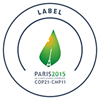�
Our Common Future Under Climate Change
International Scientific Conference 7-10 JULY 2015 Paris, France

Thomas Hawk
Transcript of Ban Ki Moon�s opening remarks
201507-07
By Our Common Future
THE SECRETARY-GENERAL
MESSAGE TO UNESCO INTERNATIONAL SCIENTIFIC CONFERENCE ON �OUR COMMON FUTURE UNDER CLIMATE CHANGE� Paris, 7 July 2015
Delivered by Mr. Michel Jarraud, Secretary-General of WMO
I am pleased to send greetings to the International Scientific Conference on �Our Common Future under Climate Change�. �I thank the organizers: the International Council for Science, Future Earth, UNESCO and major French research institutions, as well as the French Government for its support to this important event.
This year, world leaders have an historic opportunity to adopt a new sustainable development agenda and to reach a global agreement on climate change. �Both will have enormous consequences for this and future generations.
This conference could not be more timely. The scientific community has a major role to play in shaping our future. �Science provides us with the signposts of where we are, and where we are headed. �According to the Fifth Assessment Report of the Intergovernmental Panel on Climate Change, land and ocean surface temperatures have increased globally by nearly 1 degree Celsius since 1901, and in parts of Africa, Asia, North America and South America surface temperatures have risen by up to 2.5 degrees.
At the United Nations climate talks in 2010, governments committed to a maximum temperature rise of 2 degrees above pre-industrial levels. �However, the IPCC tells us that we are heading towards average global warming of 5-6 degrees. �
The world is at a critical crossroads. �Countries have been invited to submit their Intended Nationally Determined Contributions to the new climate agreement to be concluded in December, in Paris. �More than 40 developed and developing nations representing with slightly over half of global emissions have already submitted targets. �Some countries have committed up to 50 per cent reductions in greenhouse gas emissions by 2030.�
All countries must be part of the solution. �In November, the UNFCCC will release a report on the aggregate effect of INDC submissions. �However, it is already clear that current INDCs will not be sufficient to meet the 2 degree target. �Clearly, strong action still needs to be taken. �
The emissions gap � the difference between emissions reductions pledged by Parties to the UNFCCC and what is needed to stay within two degrees Celsius � has been increasing. �So, too, has the adaptation gap � the difference between funding and capacity needed and what has been committed. �To bridge these gaps, it is critical to fill holes in funding, knowledge, technology, capacity and trust.�
Science can help fill the gaps in knowledge and technology. I look forward to my Scientific Advisory Board, facilitated by UNESCO, to also providing inputs on this topic to help me, and the United Nations System to provide coherent support to Member States on climate change. �
This conference will examine transformative solutions to climate change, from initiatives in the energy sector to ecosystem adaptation and the green economy. �I commend your leadership and support in building a more resilient and sustainable future.�



